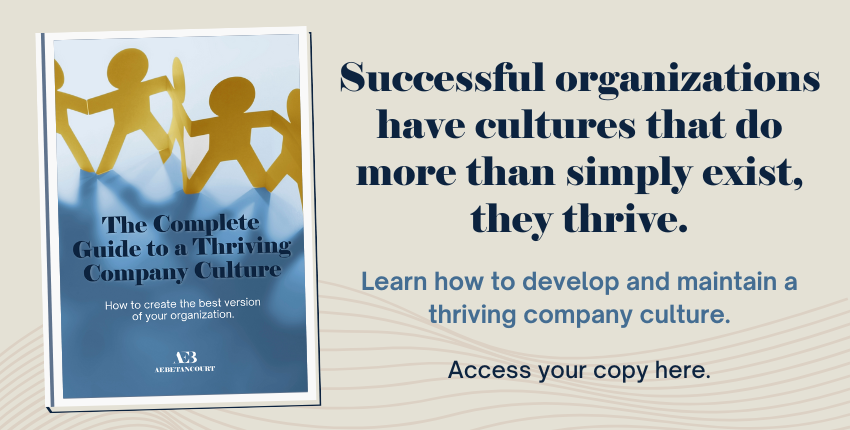How would you describe your company culture? As a leader in your organization, you are told a positive workplace culture is essential for the future of your business. But do you know what that looks like? Moreover, if your workplace culture has room for improvement (which is likely easier to identify) do you know how and where to make changes to improve it?
The Society for Human Resource Management (SHRM) describes workplace culture as the shared beliefs and values that define how to behave within an organization. Yet, SHRM also quickly points out that it is a rather vague and imprecise concept. The reason for the ambiguity is in part because the culture within a workplace can develop naturally. But this should hardly imply that a positive workplace culture cannot be built, fostered, or improved. There are indeed ways to ensure that your company’s culture is positive.
A positive workplace culture centers around effective work practices that enhance overall performance. Whereas, a poorly functioning company culture has the potential to negatively impact even the most successful businesses.
In this blog, we’ll explore the importance of a positive workplace culture, share practical tips for building your company’s workplace culture, and provide an example of what a strong and robust culture looks like.
Why You Need to Pay Attention to Your Workplace Culture?
According to LinkedIn, culture often plays a huge role in a candidate’s expectations and decisions regarding career moves. New employees don’t simply join your team, they are also entering and interacting with your workplace culture. A recent report found that 41% of job candidates in the U.S. consider an organization's culture a top priority when selecting a company to work for. This means that fostering a positive workplace culture can be crucial to building a strong business team.
However, your company’s culture goes beyond just attracting and hiring new talent. It also has a direct impact on revenue growth and financial success. More than 90% of CEOs and CFOs indicated a strong belief that the quality of a company’s culture is inextricably linked with its financial success as well as its perceived “value” in the world. A 2019 report, Return on Culture, found that organizations with a positive workplace culture are 1.5 times more likely to have revenue growth of 15% or more, throughout three years. Sadly, other research has indicated that only 31% of HR executives feel their companies have the right culture they require to drive future growth.
With so much on the line, it’s imperative that you pay attention to your workplace culture. A positive workplace culture can influence job candidates, employee outlook toward their work and how they collaborate, and can have an impact on your company’s financial performance. Your company culture can have big impacts, positive or negative, across the board — which shouldn’t come as a surprise.
When employees enjoy their workplace culture, they naturally perform better. And there are several other advantages to positive workplace cultures including improved teamwork, raised morale, increased productivity, heightened retention rates and job satisfaction, better collaboration among employees, and improved work performance. When a negative workplace culture is allowed to persist, organizational communication may suffer, micromanagement increases, as well as competition and gossip, and employees are not as engaged with each other or their work — all of which have a major impact on employee experience and satisfaction.
Culture and employee experience are two interconnected aspects of a thriving workplace. According to The Employee Experience Defined report, 49% of employees say culture influences their employee experience more than the physical environment (22%) or the technology they use to do their jobs (29%). This means that a positive workplace culture and a positive employee experience tend to go hand in hand.
How to Build a Positive Workplace Culture?
Rome wasn’t built in a day and neither is a positive workplace culture. Depending on your organization’s starting point and the level of involvement from other areas within your organization, it may take time to build a robust, positive workplace culture.
Here are 6 practical tips for building a positive workplace culture:
-
Establish organizational culture and values
Before you can begin building a positive workplace culture, it is important to outline how that culture might look and behave. Your organization will need to create a set of defined core values and then communicate them to your employees so they not only have a guide for expected performance and acceptable behavior but can incorporate the values into their working life. It is also wise to create assessments on a regular basis, so employees feel a sense of accountability for the company's values. - Ensure leadership is trustworthy
Good leaders are vital to positive workplace cultures. Leadership should constantly promote core values and serve as "culture role models." Talking about your desired culture is not enough. Leaders need to fully embrace a positive workplace culture in their actions too. Further, leadership (at both manager and senior levels) should seek opportunities to engage with employees, inspire passion, and ensure employees know they are valued. Employees that don’t feel valued will quickly lose trust in your leadership and organization, leading to lower job satisfaction and higher turnover rates, which is detrimental to workplace culture. - Proactively promote an inclusive workplace
All employees — regardless of gender, sexual orientation, race, religion, etc. — should be treated with equal respect and provided with equitable opportunities and benefits. It is crucial to consistently advocate for these principles throughout the organization. A workplace that embraces diversity and inclusivity contributes to a broader talent pool, fostering enhanced performance, creativity, and innovation. This commitment also ensures that every employee feels not only encouraged but genuinely welcomed to actively participate in the organization's culture. - Ensure employee behavior aligns with your desired culture
It is important to consider how employees react in the workplace to certain settings and scenarios because it is indicative of the culture that exists. A robust organizational culture is established when there is a cohesive display of positive behaviors, shared values, and established principles. For instance, if your organization emphasizes the significance of work-life balance, but the standard practice involves employees consistently working 13-hour days, there is a misalignment between the desired workplace culture and the actual behavior exhibited by employees. You would need to realign employee behavior to your workplace culture to ensure that employees remain engaged and morale remains high. - Set clear objectives and provide feedback
Just like setting clearly defined values, your organization will need to set clear objectives to attain and uphold those values. Employees tend to be more motivated and dedicated when they experience fair treatment and are provided with clear objectives along with feedback on their progress. A carefully designed framework enables employees to self-evaluate their performance. The presence of measurable performance criteria is essential in shaping workplace cultures as it facilitates constructive criticism, minimizes negative sentiments, and mitigates dissatisfaction among team members. By consistently reinforcing objectives and recognizing achievements, your organization can cultivate a sense of appreciation among employees, contributing to the development of a positive workplace culture. - Conduct pulse surveys
Pulse surveys are a great way to capture immediate feedback and also track progress toward your ideal workplace culture. Unlike employee assessments that are longer, more detailed, and generally conducted every 12-24 months, pulse surveys ask just a few questions about a specific topic. However, it is vital that you act upon the results of your survey results and feedback from your employees. Asking for input and then not responding appropriately will crush any efforts you make to build a positive workplace culture.
What Does a Positive Workplace Culture Looks Like?
While every workplace is different, companies with positive workplace cultures tend to have a few basic things in common, including effective communication, opportunities for growth, a culture of collaboration, reward systems, a strong sense of purpose, and clearly defined core values.
What a positive workplace culture looks like to AEB
Our company’s core values outline what we believe makes a positive workplace culture: investing in people, acting as partners, taking our own advice, and asking more of business. They are more than words on a page though. Our team worked together to define our values and remain intentional about how to model these in the workplace and with our clients.
Investing in people. We intentionally create and maintain an attractive, synergistic workplace community that fosters and celebrates excellence, diversity, recognition, personal and professional growth, innovation, and collaboration.
How have we done this? We invest in training programs to support individuals in their roles and hold in-depth training that involves the entire team. We celebrate and make a big deal out of first placements and promotions. Plus, multiple company-wide events are planned throughout the year for us to gather and connect on a personal level.
Taking our own advice. Client solutions are first our solutions. The recruiting, selection, and development solutions we deploy are well-tested and repeatedly proven in our own organization.
AEBetancourt has intentionally ended programs we could have introduced to our clients when full adoption hit challenges within our own team. We also hired ourselves to find the best talent to join us. Our rapid growth is proof our model is effective.
Acting as partners. We are transparent, honest, and open about our work results and see ourselves as true partners aligning our actions with our clients’ interests. We work hard and seek optimal on-time, on-budget, and perfect-fit solutions that build success toward our partners’ immediate and long-term talent strategy goals.
The purpose of most businesses is to support their clients with services and products that will make their organizations operate more smoothly and efficiently. We take this a step further to ensure our clients are included in every step of our process. This value is actually a mindset that is instilled into every employee from day one.
Asking more of business. Leading ethically and being a force for good in the lives of our employees, the organizations we serve, and the communities we live in is our highest calling. We provide opportunities for and incentivize our team members to volunteer for employment causes in their community.
AEB has an internal program we call Force For Good. It allocates set hours each month for employees to actively participate in community efforts and services that better the lives and career opportunities of others. Each week we create space for team members to share how they are giving back and being a positive force.
Can you measure workplace culture?
To build a positive workplace culture, your organization may need to change employee interactions and boost morale — which may seem like a daunting task. However, prioritizing the people in your organization is critical for growth. So, how do you know your efforts to build a positive workplace culture are successful? By implementing assessments and measuring specific culture metrics.
Although measuring culture directly can be challenging, its outcomes and observable behaviors can be monitored. Tracking the frequency and quality of behaviors that align with your organizational values serves as a reliable indicator of the strength of your culture. By establishing metrics based on desired value-driven behaviors, your organization can effectively assess its culture. Numerous factors serve as indicators of a positive workplace culture, and companies that prioritize cultural investment will experience evident benefits. Metrics such as employee productivity, the number of employee referrals, customer satisfaction ratings, your organization's offer-to-acceptance-to-joining ratio, and attrition rates are all valuable measures for evaluating workplace culture.
Building a Healthy Workplace Culture has Cumulative Effects
A positive workplace culture builds over time with compounding, cumulative effects. Healthy workplace cultures foster positive feelings and well-being among employees. Organizations that foster positive workplace cultures grow and strengthen employees' relationships, talent, and inventiveness. In turn, this leads to productive work environments that help increase organizational success, including business performance, client satisfaction, and efficiency.
These tips can help lay the foundation for a positive workplace culture, but it is not limited to just this list. Every workplace will build its culture a little differently because every organization is made up of unique employees with different needs and wants. However, it should be expected that every member of your organization will need to do their part in the continued success of a healthy, positive work environment.


.png)





